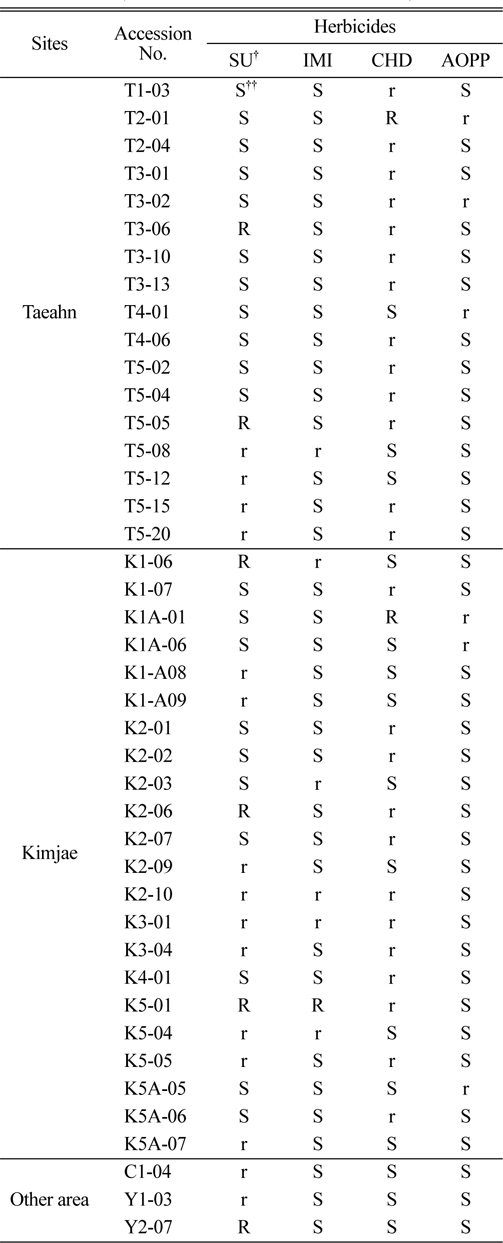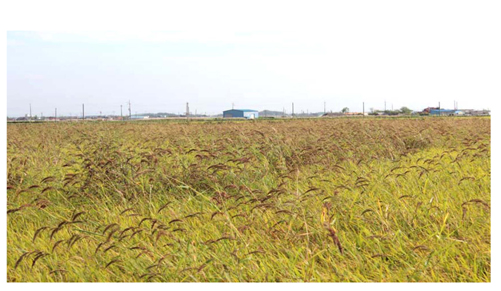



The continuous use of acetolactate synthase (ALS) and acetyl-CoA carboxylase (ACCase) inhibitors has led to the selection of herbicide resistant barnyardgrass populations in direct-seeded rice fields of Korea. This study was conducted to identify herbicide resistant barnyardgrass biotypes and to determine the cross- and multiple-resistance of them. 25% of the population collected from Taeahn was partially resistant to ACCase inhibitors and 22% collected from Kimjae were partially resistant to ALS inhibitors. However, 8.2% of the population from both sites was resistant to ALS and ACCase inhibitors. Resistance to sulfonylurea herbicide, flazasulfuron was identified from two barnyardgrass accessions collected from both Taeahn and Kimjae. One barnyardgrass accession from both sites was resistant to ACCase inhibitor, sethoxydim. The cross-resistance to ALS inhibitors was identified at one barnyardgrass accession from Taeahn and at two accessions from Kimjae. Further, crossresistance to ACCase inhibitors was also identified at barnyardgrass accessions from Taeahn and Kimjae. Multiple-resistance to flazasulfuron and sethoxydim was determined at four barnyardgrass accessions from Taeahn and at six accessions from Kimjae. Therefore, the herbicide mixture and sequences within a growing season or the herbicide rotation with different modes of actions across growing seasons are recommended to control herbicide-resistant barnyardgrass in infested fields.
The use of herbicides in crop production revolutionized weed control and played a major role in increasing agricultural productivity and efficiency. Herbicide-resistant biotypes of a weed species is the population of plants that is not controlled by the normal application rate of an herbicide. Heavy reliance on a few herbicides resulted in the evolution of herbicide resistance in crop fields. The continuous use of the same herbicide or herbicides acting on the same target site leads to the selection of herbicide resistant weed populations (Maxwell and Mortimer, 1994). Today, resistant populations against many different classes of herbicides can be found throughout the world. In Korea, herbicide resistance selected with acetolactate synthase (ALS) inhibitors was first reported in
Barnyardgrass (
In the Sacramento Valley of California, however, herbicide resistance in
Hence, this study was conducted to identify barnyardgrass populations resistant to ALS and/or ACCase inhibitors in direct-seeded rice fields in Korea and to determine the cross-resistance and multiple-resistance of barnyardgrass biotypes.
>
Seed source of barnyardgrass
A road survey of barnyardgrass plants was conducted in direct-seeded rice fields during October 2012 in Korea. Mature seeds of barnyardgrass, before rice harvest, were collected from 10 plants, each from 15 sites (155 accessions) at five locations (Kimjae, Taeahn, Daejeon, Gongju and Yesan) where barnyardgrass had failed to be controlled in the rice paddy fields (Figure 1). Barnyardgrass seeds were immersed in 4°C water for 30 days in order to remove the germination inhibitors of seeds.
>
Whole-plant herbicide resistance assay
In separate experiments, 155
After sowing the barnyardgrass seeds in pots, flazasulfuron (SU) and imazaquin (IMI) were applied at a rate of 90 and 180 g ai ha-1, respectively, and sethoxydim (CHD) and fluazifop-p-butyl (AOPP) were applied at a rate of 175 and 300 g ai ha-1, respectively, at two weeks after the emergence of barnyardgrass. Herbicide resistance of barnyardgrass seedlings was rated visually at two weeks after treatment and was assessed on a S, r, and R scale where S = death or necrosis of all plant tissues; r = visible symptoms with possible reduction in biomass; R = very mild symptoms or no visible injury.
It was determined that among 155 barnyardgrass accessions collected from 15 sites at five locations, 42 barnyardgrass accessions were resistant to at least one of ALS or ACCase inhibiting herbicides (Table 1 and 2). The assay results indicated that 25% of the population collected from both Taeahn and Kimjae were partially resistant to ACCase inhibitors, and 22% collected from Kimjae were partially resistant to ALS inhibitors. However, 8.2% of the population from both sites was resistant to ALS and ACCase inhibitors.
[Table 1.] Number of barnyardgrass accessions resistant to ALS and / or ACCase inhibitors.

Number of barnyardgrass accessions resistant to ALS and / or ACCase inhibitors.

Barnyardgrass biotypes resistant to ALS and /or ACCase inhibitors collected from the Mid-west regions of Korea in 2012 (42 accessions out of 155 accessions).
ALS inhibitors (sulfonylurea and imidazolinone herbicides) and ACCase inhibitors (cyclohexanedione, aryloxyphenoxypropionate herbicides) were used to determine the cross- and multipleresistance of barnyardgrass. Barnyardgrass highly resistant to sulfonylurea herbicide (flazasulfuron) was identified from two accessions (Accession no. T3-06 and T5-05) from Taeahn and three accessions (Accession no. K1-06, K2-06 and K5-01) from Kimjae (Table 2). One barnyardgrass accession (Accession no. T2-01) from Taeahn and one accession (Accession no. K1A-01) from Kimjae were highly resistant to ACCase herbicide (sethoxydim).
Cross-resistance is defined as a population that is resistant to two or more herbicides due to a single mechanism of resistance. Cross-resistance to ALS inhibiting herbicides was identified at one barnyardgrass accession (Accession no. T5-08) from Taeahn and five accessions (Accession no. K1-06, K2-10, K3-01, K5-01 and K5-04) from Kimjae, and crossresistance to ACCase inhibiting herbicides was also identified at two barnyardgrass accessions (Accession no. T2-01 and T3-02) from Taeahn and one accession (Accession no. K1A-01) from Kimjae (Table 2).
The biotypes of
Multiple-resistance in an herbicide resistant biotype is defined by two or more mechanisms, and is usually the result of a sequential herbicide site of action selection or the accumulation of resistant alleles. Multiple-resistance to ALS inhibiting herbicide (flazasulfuron) and ACCase inhibiting herbicide (sethoxydim) were identified at four barnyardgrass accessions (Accession no. T3-06, T5-05, T5-15 and T5-20) from Taeahn and six accessions (Accession no. K2-06, K2-10, K3-01, K3-04, K5-01 and K5-05) from Kimjae (Table 2). The continuous use of these herbicides in rice fields will increase the population of herbicide-resistant barnyardgrass.
Out of 155 barnyardgrass accessions, 42 accessions were resistant to at least one of ALS and ACCase inhibitors. Six and three accessions were cross-resistant to ALS and ACCase inhibitors, respectively. In case of cross-resistance, herbicide mixtures and sequences within a growing season, or the herbicide rotation with different modes of actions across growing seasons, are recommended to manage the herbicideresistant barnyardgrass populations. However, 10 accessions of barnyardgrass showed multiple-resistance to both ALS and ACCase inhibitors indicating reduced herbicide options to rotate. To better understand and manage these barnyardgrass populations, dose response and resistance mechanism of each accession should be conducted in future.


